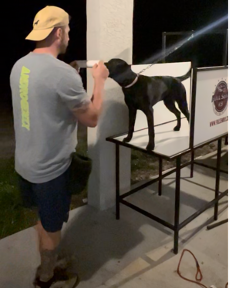CA - Unforced Force Fetch Part 3
- Tim Andrews
- Jul 30, 2024
- 3 min read
by Christopher Armanini of Full Send K9
POWER FETCHING
Power fetching is a specialized training method aimed at enhancing a dog's fetch skills through strategic techniques. This approach is meticulously crafted to ignite the dog's passion, determination, and enthusiasm throughout the fetching process.
One of the key components of power fetching is harnessing the dog's opposition reflex. This reflex is triggered by the use of a bungee line, which creates tension and activates the dog's innate urge to forge forward and resist back pressure. By leveraging this reflex, we can encourage the dog to reach further and retrieve with greater speed and intensity.
Before starting, the dog should already have a solid grasp of fetching, holding onto items, and releasing them on command. During training, the dog is secured to a table with a leash/chain attached to a short bungee cord.

The objective of this method is to prompt the dog to engage its opposition reflex actively during fetches. Understanding this behavior and its mechanics is crucial.
Opposition reflex is the dog's instinctive response to physical pressure; when encountering resistance, dogs naturally push or pull against it. This is why at times you see 3-pound yorkies choking themselves on leash when walking or if you try to physically push a dog into a down they fight against it. They cannot control this reaction to the pressure. Some dogs and breeds inherently pull/push harder than others. It is also important to mention that this is the same reason why sled dogs pull on a harness. It is a tactile que that encourages the forging behavior. We can utilize this natural behavior to enhance fetch training.
When a dog fights for a behavior this helps the dog find their advantage by staying in the wanted behavior, thus meeting the human's needs simultaneously. The act of the fight/struggle is negative reinforcement.
Procedure:
The dog will be back tied to the bungee on the table. I will be approximately 10’ away from the dog and present the item for the dog to fetch holding it at eye level. I will then slowly walk in towards the dog. The goal is to elicit anticipation and frustration from the dog, encouraging it to lean into the bungee cord in an effort to reach out for the item.

As I approach the dog, I will present the item for them to fetch right on the edge to where they can barely grab it. I want the dog to give their all to get the item from my hand. It is at that moment just before the dog can grab the item that I am giving the fetch command. Once the dog has the item they are able to relieve themselves from the back pressure which was acting as the negative reinforcement to the fetch. I then grab the item from the dog, give the out command and reward.
Occasionally, I may approach the dog in the same manner and just prior to the point that I would allow the dog to grab the item, I turn and run away. This teasing behavior can induce more frustration and motivation on the subsequent repetition as it was a form of negative punishment, translating to the dog to try harder. It important not to do this often as it can decrease hope in the dog.
Through consistent repetition, the dog's muscles will develop a memory of the fetch exercise. This muscle memory plays a crucial role in fostering an explosive behavior, wherein the dog becomes more responsive and initiates the act of reaching out for the item
With time and consistency, the application of pressure during the fetch exercise transforms into a powerful drive and motivation for the dog. As the power fetching technique progresses, we gradually modify the overall fetch experience to enhance the dog's performance and achieve optimal results.








Comments